Serragon
03/18/2025
If you think about it, PT Aetherdrift is technically my worse PT finish - I had the same record with worse breakers compared to PT MKM; and Worlds technically isn't a PT!
I would say that my tournament was somewhat carried by my constructed performance. I only went 3-3 in draft (in my mind mostly but not entirely due to some bad variance, but I won't get into that here), but my Standard record was as good as usual at 8-2. Maybe at this point I am becoming a "constructed specialist" :P

my PT deck
Certainly, I really liked my Standard deck. In my mind, the Serragon deck (coverage would call it "Esper Paragon") was an excellent metagame call for the tournament - and I would still stand by it as a choice in the post-PT metagame too. But, as a disclaimer: even though I went 8-2, the others on my team who registered the deck had a combined winrate that was less than 40%. So, maybe it's a bit of a mixed bag.
Regardless, my purpose here is to simply lay out my thoughts on the deck. Why we built the deck, how it works, how to play it, and how to continue iterating on it going forward. I won't necessarily go so far as to actively recommend the deck to anyone else given the spotty record and metagame nature of it, but it's certainly good to keep it in mind. And even if you aren't interested in playing the deck itself, hopefully you'll learn something from reading this!
Part 1: How Did We Get Here?
The Best Card in Standard
Exploring Standard for PT Aetherdrift was an interesting process. We on Sanctum certainly tried to break the format - with old brews like Otters or new brews like Lotus Pod - but in the end we never really found a deck that seemed inherently stronger than any of Pixie, Domain, or Rx aggro.
Given that, in my mind the next best option was trying to game the metagame. What deck could both beat the fast starts and small games of Pixie and Rx aggro, while also being able to contend with Domain's big games?
My first thought was to look at what the "most powerful" cards in Standard were. Obviously this is somewhat of a nonsense, highly contextual question; but the point was more to find a place to draw inspiration from, rather than to determine a specific "best card".
To me, the card that instantly came to mind was
Nurturing Pixie. The Esper Pixie deck very much leans on its power and efficiency, as just a 1 mana 2/2 flier that draws a card. In terms of other threats in Standard, nothing comes close to its combined efficiency card- and mana-wise.Of course, one thing you could conclude from the thought "Pixie is the best card in Standard" is that well, maybe you should just play the deck named after it. Certainly that was the conclusion of six of our team members. And those team members had a combined 59.5% constructed winrate, so perhaps that was in fact the answer.
But throughout much of our testing process, I was afraid that Pixie had too much of a target on its back. It had been doing well in online challenges, and seemed to me like it was the deck to beat. I also didn't love that it was somewhat inconsistent as a deck - as an A+B deck, some draws were extremely powerful, but the hands without both an enchantment and a card to pick it up were quite anemic.
As such, I started thinking about various shells that could play the card Pixie, without some of the same weaknesses that Pixie as a deck had.
Serra Paragon
At some point, Noor mentioned off-hand that
Serra Paragon and Momentum Breaker had neat synergies with each other - you could sacrifice Breaker to be able to recast it with Serragon, and then later sacrifice it again to gain even more life off o the Serragon "gain 2 life and exile this" trigger.I had been looking for a way to build a bigger, more controlling Pixie deck, so as soon as I saw this the pieces clicked into place. Maybe Serragon was the lategame engine that could make a bigger Pixie deck tick.
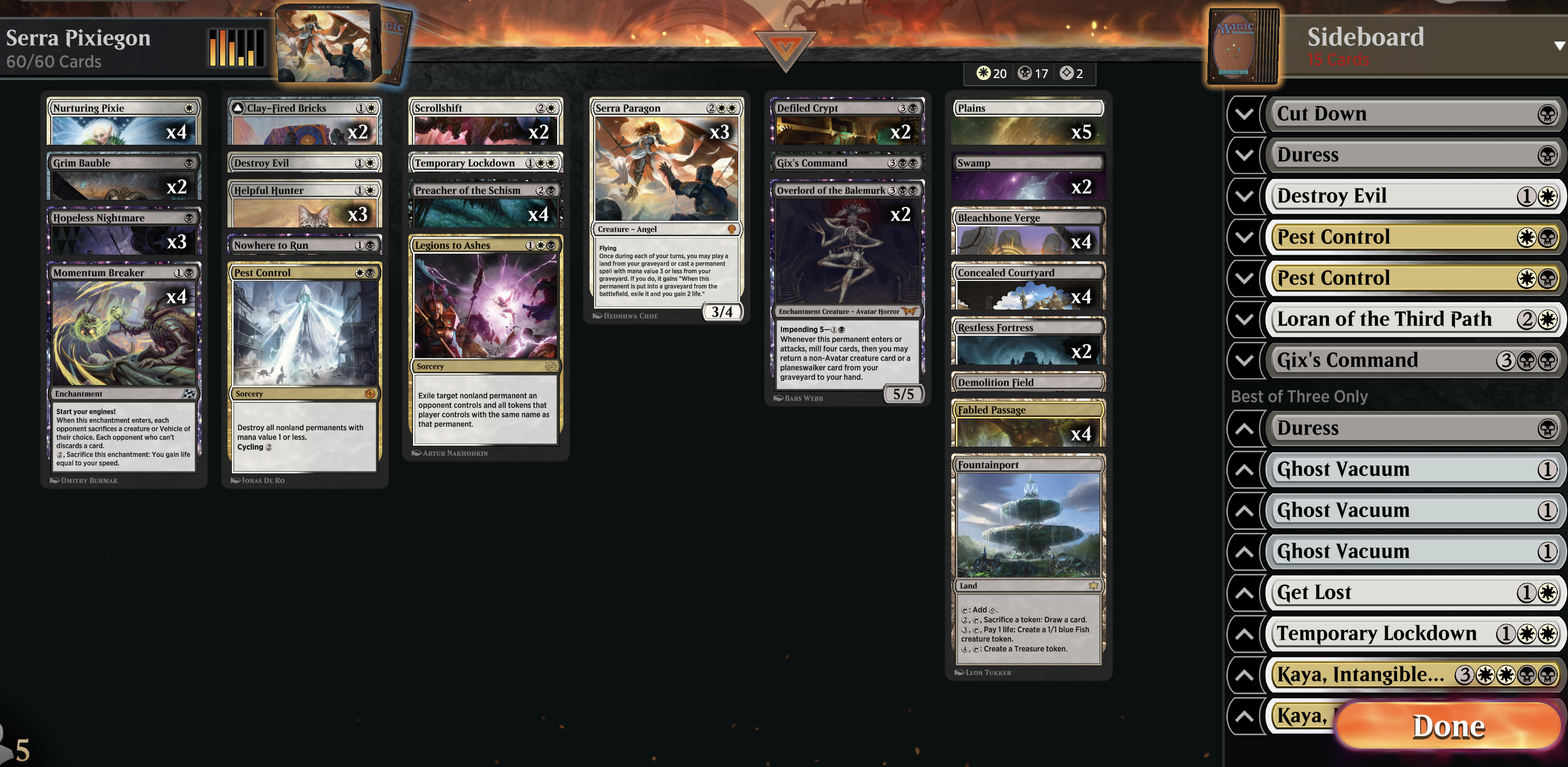
my original Orzhov build
I threw together a quick Orzhov build to play on ladder, and it honestly seemed pretty promising! The card Serra Paragon proved quite strong against both red aggro and pixie deck, and the dynamic of Pixie picking up removal spells was generally quite strong vs any creature decks.
The weakest point of the deck seemed to be the copies of
Preacher of the Schism, and the inability of it to deal with decks like Domain that went even bigger than it. But this iteration was still a fairly early one, and I was hopeful that those issues could be fixed.Jace, the Perfected Mind
This is around when cftsoc suggested
Jace, the Perfected Mind - which, as far as I'm concerned, solved all problems.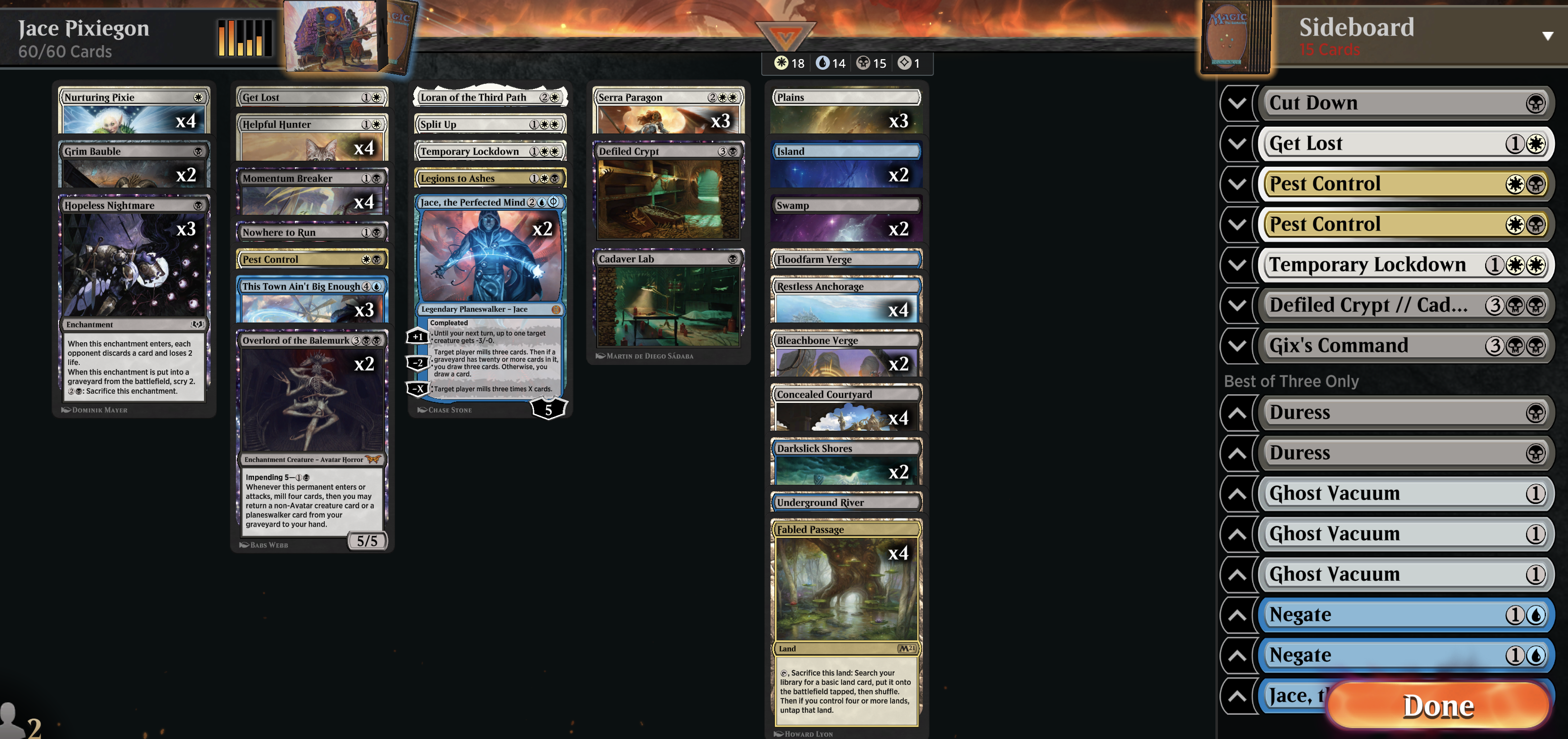
the next iteration, perfected with Jace
It might look weird to splash a double blue card as basically your only blue card, but Jace just patches an extremely important hole singlehandedly by providing a way to close out long games very quickly. And this deck was very good at utilizing it, as you can reset it over and over again with Pixie,
Overlord, and TTABE to turbo mill your opponent out.Jace also served as a nice replacement for Preacher - a card advantage engine that played better with the rest of the deck, and filled the 3-drop slot quite nicely. Plus, adding blue let us play a vastly superior creature land -
Restless Anchorage - and one of the best interaction spells in Standard, TTABE!Hopeful Dreams
The final big change in the deck was deciding that it was no longer a
Hopeless Nightmare deck. When I first built it, the theory was that maybe Pixie+Nightmare would be good vs Domain. But after playing games, it turned out that Nightmare just... didn't seem impactful in any matchup, really.The best place for it was probably against aggressive decks without much card advantage, like Gruul. But since the deck was now quite more of a control deck than a midrange deck, it was extremely bad at taking advantage of the damage from Nightmare, so it was kind of just a Raven's Crime.
There was a bit of worry that this would result in not having enough cards for Pixie to bounce, but after playing without it for a while, it ultimately seems fine. Sure, Pixie will no longer be a turn 2 play nearly as much, but there were still enough cards to enable a turn 3 Pixie, and that was a fine enough curve when you don't care about attacking with it.
Part 2: How Does This Deck Work?
Barely Coherent (But Still Coherent!) Silver Bullets
One of the core premises of this deck is that it is trying to enact several distinct plans that each are fairly fucked up against a different portion of the metagame. These plans generally mostly center around single cards; and while trying to fully utilize all of them at once would lead to an incoherent mess, each card has at least some amount of smaller value in furthering other gameplans.
The three biggest examples are, of course, the three cards I mentioned as key cards during the deckbuilding process:
Nurturing Pixie, Serra Paragon, and Jace, the Perfected Mind.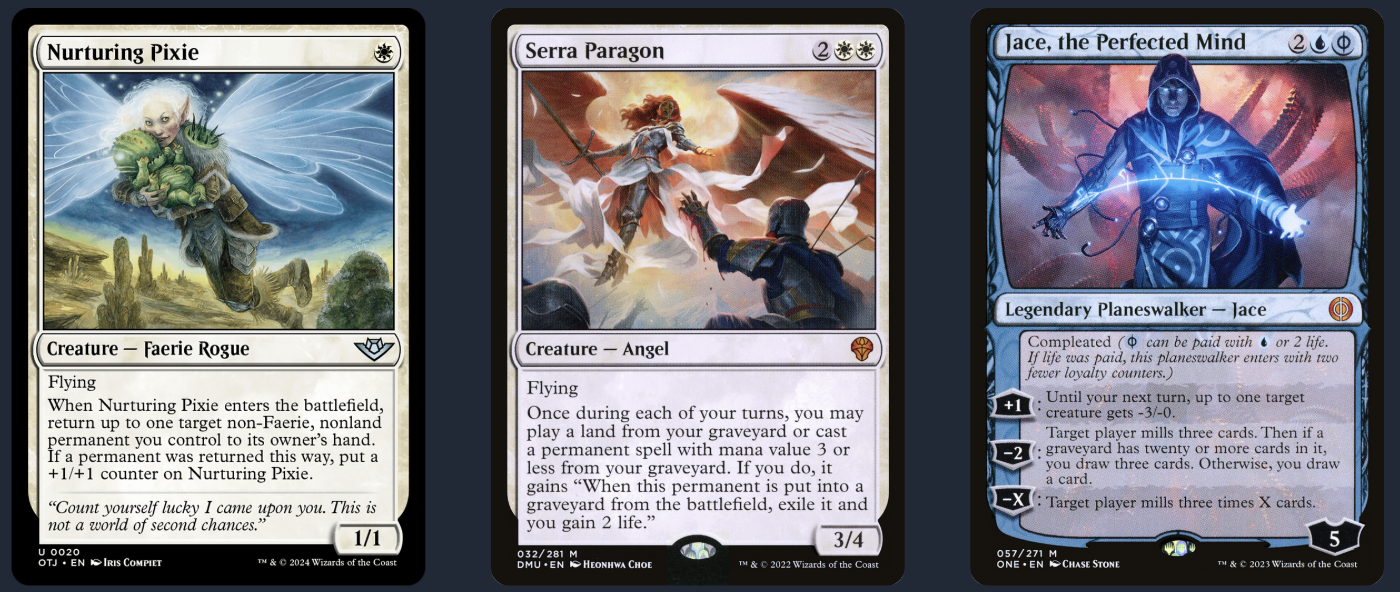
pixie, serragon, and jace - the pillars of the deck
Pixie, when combined with removal permanents like
Momentum Breaker and Grim Bauble, is an extremely strong rate card against creature decks - most notably red aggro. Bauble especially is a key card here in combination with Pixie, as spending 2 cards and 3 total mana to remove 2 of Gruul's creatures and leave behind a body sets you up to never lose the early game.Serragon in this deck functions as a an extremely strong and stabilizing but ultimately fair lategame. Any deck that doesn't go much over the top of you will struggle to be able to play through a Serragon, and much of the commonly-played removal in the format doesn't kill 4 toughness creatures well.
Nowhere to Run and Momentum Breaker both look kind of silly against a board of Serragon and Helpful Hunter. As such, your lategame plan against decks like Gruul, Pixie, or any midrange pile generally just looks like hitting many land drops and recurring many removal spells and Pixies with Serragon.Finally, Jace serves as your I-win button against Domain, Oculus, and control and combo decks. Sure, maybe two full Jace activations will only kill Oculus these days, as Domain moves away from Atraxa - but this deck is very good at getting in three activations, with Pixie and
Overlord of the Balemurk there to help rebuy it.And it might seem at first glance that these distinct gameplans don't really help eachother that well. And indeed, you shouldn't generally be trying to mill out Gruul, and Serragon isn't going to beat Domain at all.
But even against creatureless matchups, Pixie can still pick up Helpful Hunter to draw cards or Jaces to kill. And even against combo decks, Serragon helps hit your land drops, replays hatepieces, and extends the game to help you get to your Jace plan. And even against aggressive matchups, Jace can be a reasonable planeswalker with its +1 buying time for your wraths or Serragons, and its -2 filling your graveyard for Serragon.
The Rest of the Deck: Core Glue
There are a few cards in the deck that aren't exactly the headliner cards, but are still very important to the deck. These are the cards that help the deck run smoothly; cutting them would be a very bad idea.
First up is
Overlord of the Balemurk. This helps assemble all your pieces, finding your three most important cards while also filling the graveyard for Serragon. It also functions as something you can pick up with Pixie, though you would rather just leave it in play to become a 5/5 at some later point.Helpful Hunter, despite looking quite innocuous, is actually fairly comparable to Overlord in this regard. It, too, is an arbitrary gamepiece that you can move between zones to generage card advantage, and this one can even be cast from the graveyard with Serragon!
Where Overlord digs towards your good cards, Hunter digs towards your land drops. Where Overlord serves as an extra free 5/5 at some point, Hunter helps you get to that point by chumping. While your instinct may be to dismiss the draft chaff common in favor of the mythic rare, both are vitality important to the functioning of the deck, and neither can fully replace the other.
Finally, there are the bouncable removal spells -
Momentum Breaker, Nowhere to Run, and Grim Bauble. You could maybe play a different split of these, or one copy more or less, but you do really need to have some density of this kind of effect for the creature matchups.The Rest of the Deck: Flex Slots
The cards above are the core of the deck, cards that are important to its structure that you would be hard pressed to replace. That leaves about 12 flex slots for various wraths, removal, and hatepieces.
We elected to play three wraths maindeck at the PT: two
Day of Judgment and one Temporary Lockdown. Lockdown is of course your best possible card vs red aggro, but DoJ is much more flexible - it's even good vs Domain! I would not recommend playing fewer wraths than this.In terms of single-target removal, we generally prioritized cards that could deal with planeswalkers, as we were specifically worried about
Kaito, Bane of Nightmares. Two copies of TTABE and one each of Sheoldred's Edict, Get Lost, and Legions to Ashes looks weird, but removal splits in controlling decks are generally quite nice.Loran of the Third Path and Beza, the Bounding Spring serve as maindeck "hatepieces" that can be found off of Overlord; we wanted a few more good hits, and figured these creatures had wide enough coverage to be worth maindecking.
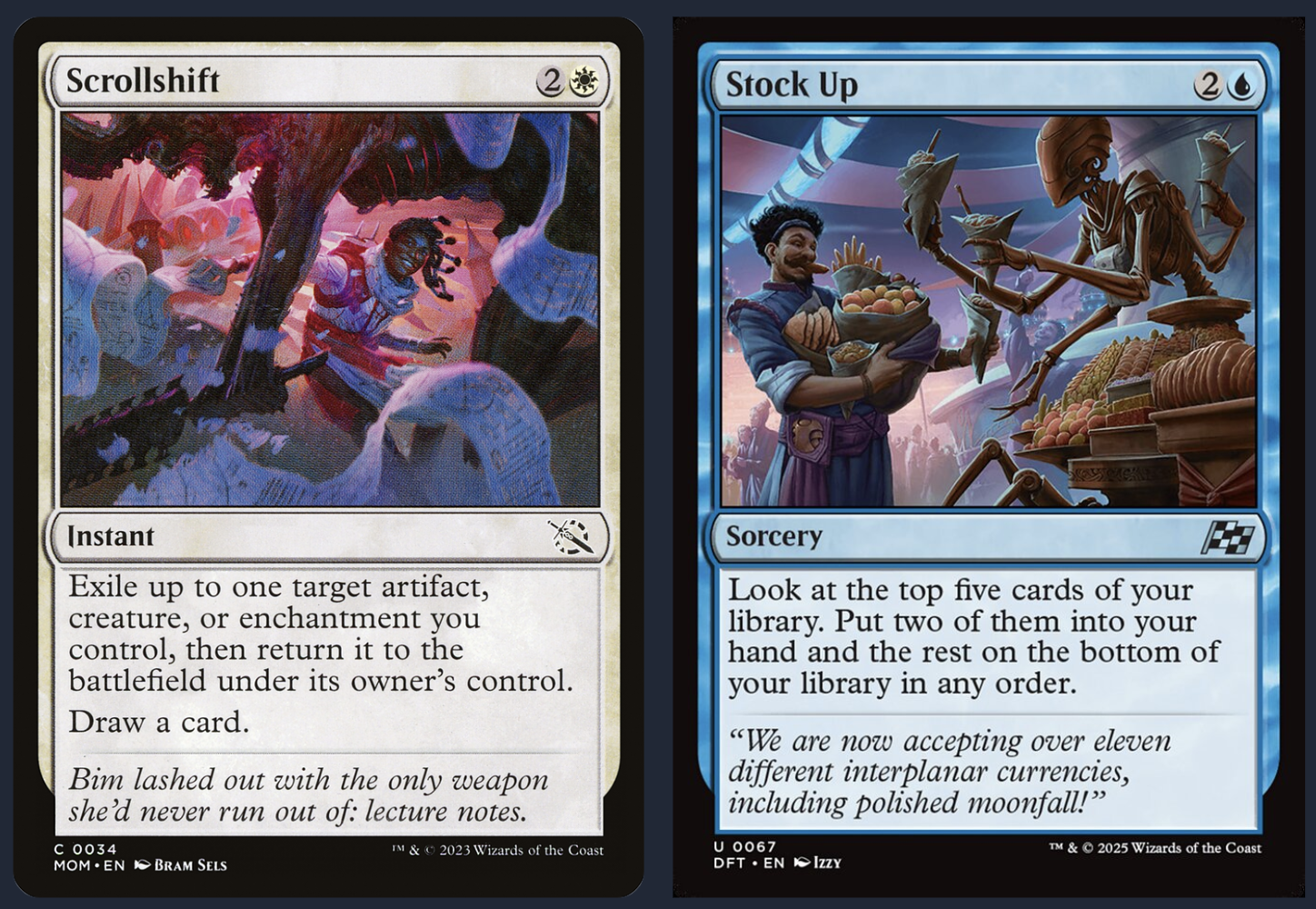
And finally, the most controversial slot:
Scrollshift. This was the last decision we made - whether to play Scrollshift or Stock Up in this "a little bit more card acceleration" slot. Scrollshift has the benefit of being a bit more agile and a bit better tempo-wise; while Stock Up has the benefit of digging much further for your pieces. Scrollshift gives you a potential threatening turn 3 play (curving Overlord into Scrollshift, though it isn't quite as impressive as it first sounds), while Stock Up better helps fix your awkward hands in the lategame.I think which one you bias towards entirely depends on what you expect the metagame to look like. If you expect more Pixie and red aggro, Scrollshift is going to look better; if you expect more Domain and combo, Stock Up is going to look better. At the PT, I expected more of the former, and so elected to register Scrollshift; others on my team were less sold though. But now, I might lean the other way, with Omniscience combo becoming more popular.
And while this slot isn't strictly necessary, I would recommend playing something divination-like that helps smooth your draws a little bit more. That honestly could just mean another Jace, though.
Part 3: How Do You Play This Deck?
The play patterns of this deck aren't particularly complex, especially compared to some of the intricate combo decks I've written about in the past.
But that is not to say that this deck (or any deck, tbh) is easy to play, by any stretch. This one tests a very particular kind of skill: scrapping out long games with very little card selection.
Mulligan Well, Mulligan Often
Outside of Stock Up, this deck doesn't have very much card selection. You have some card draw, but generally you will have to be able to build a gameplan with tools you have access to.
This means that you need to make sure that the set of tools you start with are good. Don't keep hands full of creature removal against Domain; and don't keep hands without any removal against Gruul.
That said, this is one of the weaknesses of this deck in closed decklist. It is a highly reactive deck, and not being able to mull away situationally bad hands in game 1 loses you significant points against matchups like Domain.
This isn't to say the deck is unplayable in closed decklist, though, just worse. Most of your reasonable hands will still be good against most matchups, and winning game 1 doesn't matter if you just win games 2 and 3!
Prolong the Game, Play to Your Outs
This is a deck that is very good at topdecking. It has a lot of cards that can artificially prolong the game - lifegain from Serragon and Momentum Breaker, and many repeated chump blocks from Helpful Hunters and Pixies. And it has many cards that can turn a game around quite quickly - resetting the board with a wrath, stabilizing with Serragon, and in some matchups milling your opponent with Jace.
As such, in most cases you should be trying to prolong the game as much as you can. Don't be afraid to chump block early with your Helpful Hunters - they might be better in the graveyard for you to recur with Serragon anyways.
And as part of this, this deck is very good at presenting forks for your opponent. You can be annoyingly good at stabilizing against aggressive strategies, forcing them to commit more resources into your wraths. You can force Domain to play aggressively to beat your Jace plan, only for them to run into a wrath. Even the dynamic of Momentum Breaker vs Day of Judgment is a bit of a fork: play around the wrath and get high-value creatures edicted, play around the edict and get a wide board wrathed.
Know How to Close
At the same time, while you should be trying to prolong the game, you should also be looking for opportunities to close it. Again, because the deck doesn't have much card selection, it is possible to flood out, and it is possible for some matchups to eventually circumvent your lategame - whether that means red aggro burning you out or Domain eventually assembling multiple copies of
Up the Beanstalk.The key is to know exactly how many resources you need to use defensively each turn, and therefore exactly how many you can commit to further your victory. How many creatures do you need to block or chump red creatures with, and how many are free to attack? Do you need to hold up removal to interact with Omni combo, or is this your best window for developing a Jace?
These questions are the hardest part of playing a controlling deck like this one. They really ask you to have a deep understanding of how your opponent's deck works, so that you know how to properly assess their threats.
Line Up Your Answers
One way to think about navigating games with this deck is figuring out exactly how your answers are lining up with your opponent's threats. You won't generally have an abundance of resources until deep into garbage time, so you often need to figure out exactly how you should be apportioning out your answers.
For example: consider whether you really need to wrath your Gruul opponent's board of two creatures, or if can you just play a Pixie and a removal spell, and pressure them to commit some of their harder-to-deal-with threats into your wrath.
At each point you should be thinking about not only answering the threats your opponent has on board, but also the threats your opponent is likely to have in hand or in their next few draw steps. Lining up the right answers to the right threats is key, as the deck is all about maximizing the efficiency of your answers and getting those small edges. Your interaction suite is powerful, but they all have conditions - don't be left holding a circular key for the square hole your opponent presents, so to speak.
For example: whether to spend a
Nowhere to Run or a Grim Bauble to kill an opposing Emberheart Challenger on turn 2 is highly contextual. Nowhere to Run uses your mana better (unless you also have a Pixie to play), and that might be appealing - but if that's going to leave you with nothing in hand to deal with a potential Screaming Nemesis, then you probably should consider using the Bauble.Part 4: A List and Sideboard Mapping
This is getting long so I'm not going to type out a full guide to sideboarding, and instead leave you with my current list and mapping, along with some brief notes.
The List
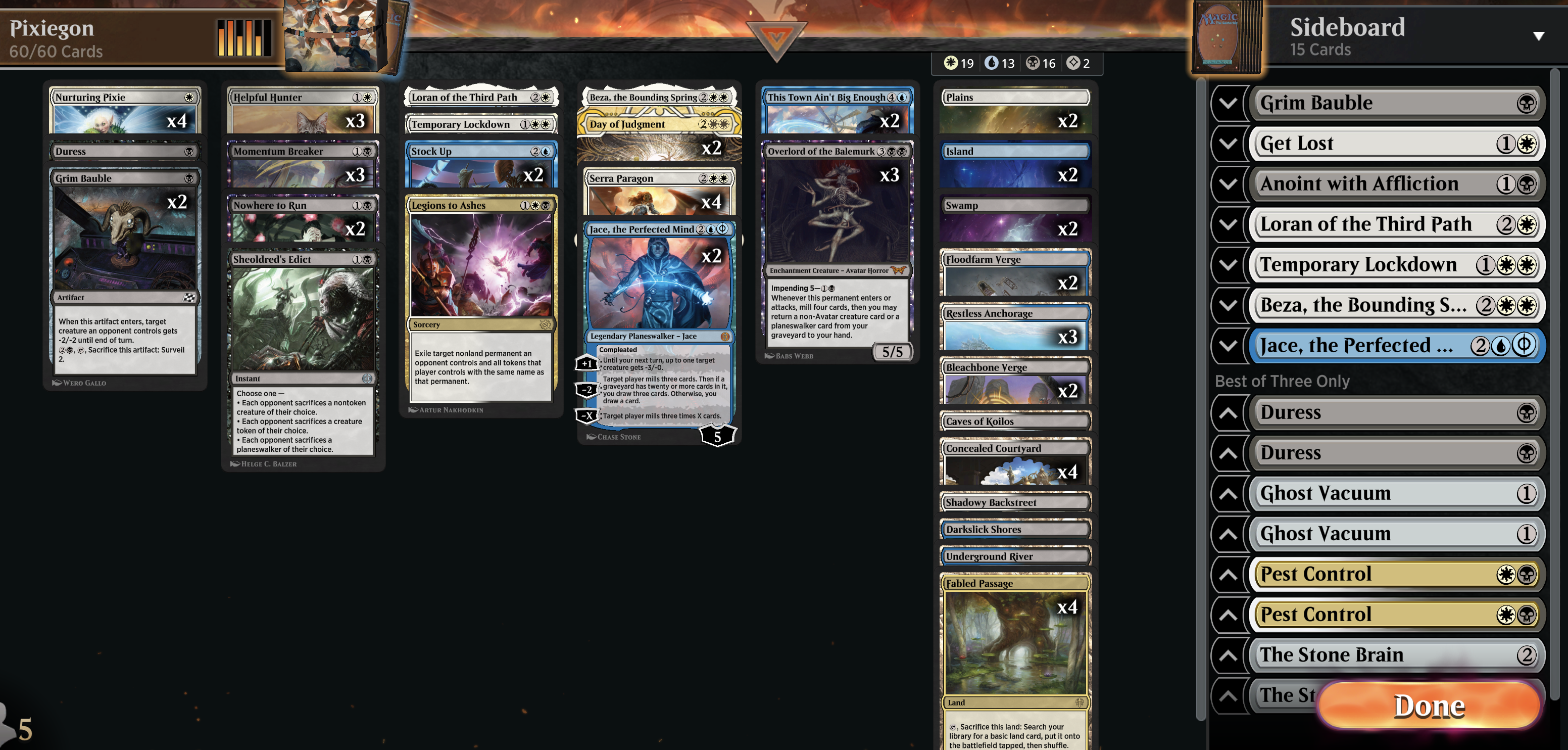
my current serragon list
Earlier today I went to a 16-player RCQ at The Brooklyn Strategist with this list (well, with a couple minor substitutions for card availability reasons :/). I only lost 1 game the entire event (game 1 against Omni combo), scooping the finals for the store credit since I wasn't going to use the invite.
I decided to play Stock Ups because I was expecting some amount of Omni combo, and preferred Stock Up in closed decklist to help smooth out bad hands kept in the blind game 1. I also have two copies of
The Stone Brain in the sideboard, also for Omni combo - I ended up facing the only Omni player during Swiss though, so they did somewhat pay off.You could choose to respect Omni more or less, but I do think it's this deck's worse matchup so having two dedicated slots isn't preposterous. You could also play a third
Ghost Vacuum to also have more game vs Oculus, but I do really like just how much The Stone Brain swings the Omni matchup (naming Omniscience, or maybe Abuelo's Awakening if they have Gearhulks postboard).The Mapping
Here is my mapping spreadsheet. You can see the mapping for my PT list, as well as mapping for my current list, both in separate tabs.
Sideboarding isn't too complicated with this deck; mostly you just put in the good silver bullets and take out the bad silver bullets.
Conclusion
I am personally still a big fan of Serragon post-PT. Its track record certainly isn't spotless, but with more respect for Omni combo I believe it to still be an excellent choice into the current metagame.
Domain and aggressive strategies in general should be quite favorable, Pixie and Oculus are close depending on how both decks are built and played, and Omni combo should be quite manageable with access to both The Stone Brain and Ghost Vacuum. The "Other" category is perhaps the area of most concern - as this is inherently a deck built to fight a metagame - but the deck is good enough at dealing with creatures that you still have a lot of game.
It's also certainly a space to pay attention to going forward with new set releases - the deck functions moreso on slots than on very specific card choices, so it shouldn't be hard to slot in new strong cards, and new silver bullets as the meta shifts.
#FreePalestine | Consider donating to UNWRA or PCRF, supporting protesters locally, and educating yourself.
